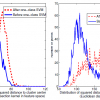23 search results - page 1 / 5 » Additive Distances and Quasi-Distances Between Words |
JUCS
2002
15 years 1 days ago
2002
: We study additive distances and quasi-distances between words. We show that every additive distance is finite. We then prove that every additive quasi-distance is regularity-pres...
117
Voted
MLCW
2005
Springer
15 years 5 months ago
2005
Springer
The Recognizing Textual Entailment System shown here is based on the use of a broad-coverage parser to extract dependency relationships; in addition, WordNet relations are used to ...
111
Voted
ICCV
2009
IEEE
16 years 5 months ago
2009
IEEE
Common visual codebook generation methods used in
a Bag of Visual words model, e.g. k-means or Gaussian
Mixture Model, use the Euclidean distance to cluster features
into visual...
128
Voted
TIT
2008
15 years 8 days ago
2008
The term binary combinatorial Gray code refers to a list of binary words such that the Hamming distance between two neighboring words is one and the list satisfies some additional ...
92
Voted
CORR
2010
Springer
15 years 14 days ago
2010
Springer
While Kolmogorov complexity is the accepted absolute measure of information content in an individual finite object, a similarly absolute notion is needed for the information distan...

